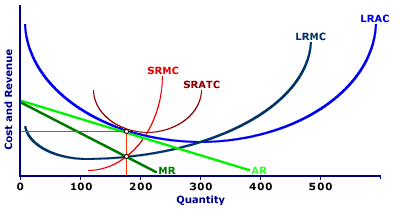Long-Run Adjustment
Long Run Adjustment
- Firm Adjustment: Each firm in the monopolistically competitive industry adjusts short-run production and long-run plant size to achieve profit maximization. This adjustment entails producing the quantity that equates marginal revenue',500,400)">marginal revenue to short run marginal cost for a given plant size as well as selecting the plant size that equates marginal revenue to long-run marginal cost.
- Industry Adjustment: Firms enter and exit a monopolistically competitive industry in response to economic profit and loss. If firms in the industry earn above-normal profit or receive economic profit, then other firms are induced to enter. If firms in the industry receive below-normal profit or incur economic loss, then existing firms are induced to exit. The entry and exit of firms causes the market price to change, which eliminates economic profit and loss, and leads to exactly normal profit.
Long-Run Equilibrium Conditions
With marginal revenue (MR) equal to marginal cost (MC and LRMC), each firm maximizes profit and has no reason to adjust its quantity of output or plant size. With price (P) equal to average cost (ATC and LRAC), each firm in the industry is earning only a normal profit. Economic profit is zero and there is no economic loss.
The six specific equilibrium conditions achieved by long-run equilibrium of monopolistically competitive industry are: (1) economic inefficiency (P > MC), (2) profit maximization (MR = MC), (3) market control (P = AR > MR), (4) breakeven output (P = AR = ATC), (5) excess capacity (ATC > MC), and (6) economies of scale (LRAC > LRMC).
These conditions are only satisfied by the tangency of the negatively-sloped demand (average revenue) curve facing a monopolistically competitive industry and the economies of scale portion of the long-run average cost curve. This means that a monopolistically competitive firm does not achieve long-run economic efficiency.
Key to these conditions is that they are NOT equal. Because price is not equal to marginal revenue in monopolistic competition average cost is not equal to marginal cost. The only production level in which average cost is equal to marginal cost (both short run and long run) is at the minimum efficient scale',500,400)">minimum efficient scale of production, the bottom of the long-run average cost curve. The only way to achieve this production level is the equality between price and marginal revenue. This equality is only achieved by perfect competition.
*COMMENT
In the long run, a monopolistically competitive firm adjusts plant size, or the quantity of capital, to maximize long-run profit. In addition, the entry and exit of firms into and out of a monopolistically competitive market eliminates economic profit and guarantees that each monopolistically competitive firm earns nothing more or less than a normal profit.
No comments:
Post a Comment